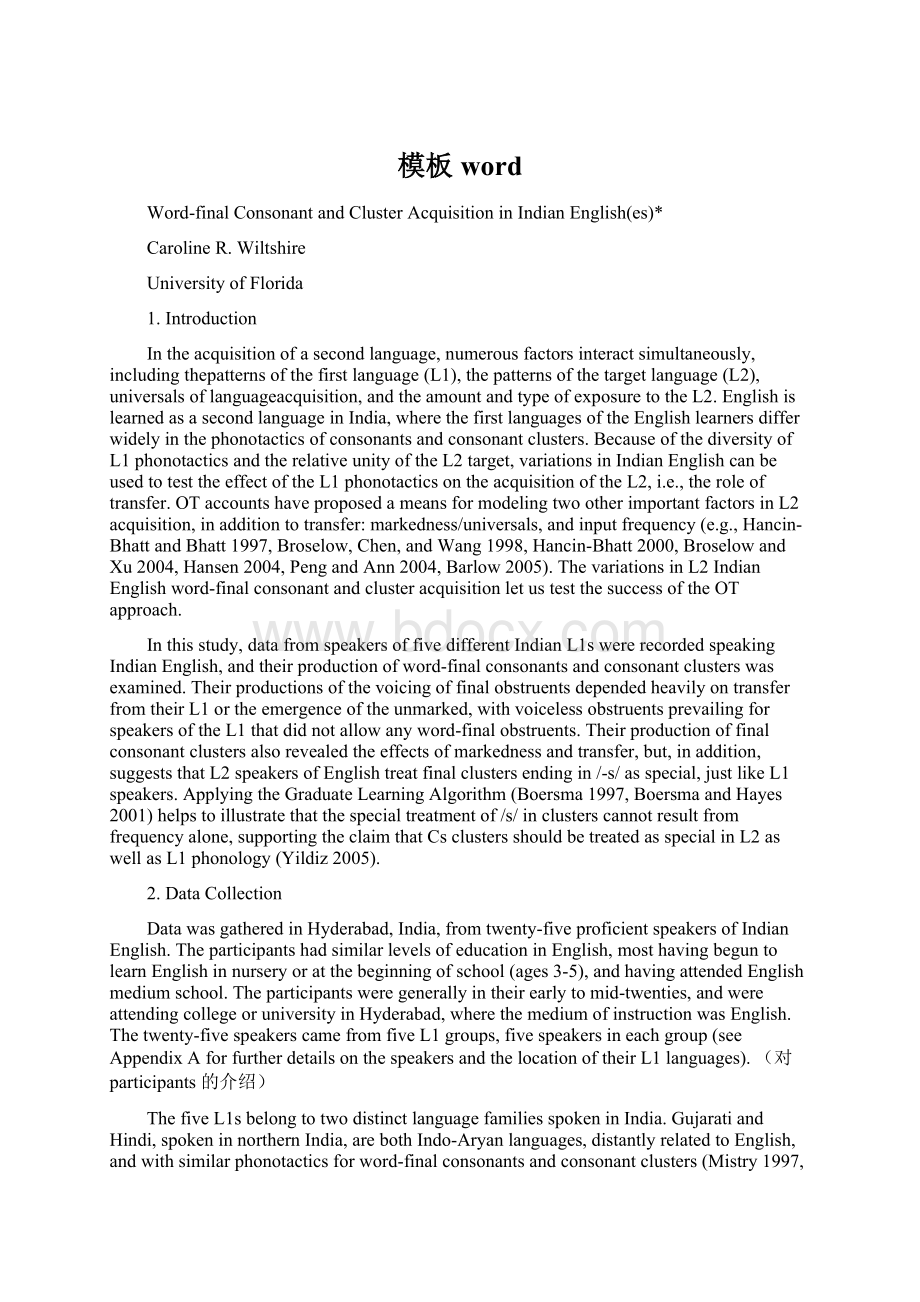模板word.docx
《模板word.docx》由会员分享,可在线阅读,更多相关《模板word.docx(18页珍藏版)》请在冰豆网上搜索。

模板word
Word-finalConsonantandClusterAcquisitioninIndianEnglish(es)*
CarolineR.Wiltshire
UniversityofFlorida
1.Introduction
Intheacquisitionofasecondlanguage,numerousfactorsinteractsimultaneously,includingthepatternsofthefirstlanguage(L1),thepatternsofthetargetlanguage(L2),universalsoflanguageacquisition,andtheamountandtypeofexposuretotheL2.EnglishislearnedasasecondlanguageinIndia,wherethefirstlanguagesoftheEnglishlearnersdifferwidelyinthephonotacticsofconsonantsandconsonantclusters.BecauseofthediversityofL1phonotacticsandtherelativeunityoftheL2target,variationsinIndianEnglishcanbeusedtotesttheeffectoftheL1phonotacticsontheacquisitionoftheL2,i.e.,theroleoftransfer.OTaccountshaveproposedameansformodelingtwootherimportantfactorsinL2acquisition,inadditiontotransfer:
markedness/universals,andinputfrequency(e.g.,Hancin-BhattandBhatt1997,Broselow,Chen,andWang1998,Hancin-Bhatt2000,BroselowandXu2004,Hansen2004,PengandAnn2004,Barlow2005).ThevariationsinL2IndianEnglishword-finalconsonantandclusteracquisitionletustestthesuccessoftheOTapproach.
Inthisstudy,datafromspeakersoffivedifferentIndianL1swererecordedspeakingIndianEnglish,andtheirproductionofword-finalconsonantsandconsonantclusterswasexamined.TheirproductionsofthevoicingoffinalobstruentsdependedheavilyontransferfromtheirL1ortheemergenceoftheunmarked,withvoicelessobstruentsprevailingforspeakersoftheL1thatdidnotallowanyword-finalobstruents.Theirproductionoffinalconsonantclustersalsorevealedtheeffectsofmarkednessandtransfer,but,inaddition,suggeststhatL2speakersofEnglishtreatfinalclustersendingin/-s/asspecial,justlikeL1speakers.ApplyingtheGraduateLearningAlgorithm(Boersma1997,BoersmaandHayes2001)helpstoillustratethatthespecialtreatmentof/s/inclusterscannotresultfromfrequencyalone,supportingtheclaimthatCsclustersshouldbetreatedasspecialinL2aswellasL1phonology(Yildiz2005).
2.DataCollection
DatawasgatheredinHyderabad,India,fromtwenty-fiveproficientspeakersofIndianEnglish.TheparticipantshadsimilarlevelsofeducationinEnglish,mosthavingbeguntolearnEnglishinnurseryoratthebeginningofschool(ages3-5),andhavingattendedEnglishmediumschool.Theparticipantsweregenerallyintheirearlytomid-twenties,andwereattendingcollegeoruniversityinHyderabad,wherethemediumofinstructionwasEnglish.Thetwenty-fivespeakerscamefromfiveL1groups,fivespeakersineachgroup(seeAppendixAforfurtherdetailsonthespeakersandthelocationoftheirL1languages).(对participants的介绍)
ThefiveL1sbelongtotwodistinctlanguagefamiliesspokeninIndia.GujaratiandHindi,spokeninnorthernIndia,arebothIndo-Aryanlanguages,distantlyrelatedtoEnglish,andwithsimilarphonotacticsforword-finalconsonantsandconsonantclusters(Mistry1997,Ohala1999).Theotherthree,Angami,Ao,andMizo,arespokeninthenorth-eastpartofIndiainthestatesofNagalandandMizoram;theselanguagesarefromtheTibeto-Burmanlanguagefamilyandrequiremuchsimplersyllablestructure.AngamiallowsonlyCVsyllables,withnofinalconsonantsorclusters(Ravindran1974).MizoandAoeachallowonlyasingleconsonantword-finally,limitedtoeitherasonorantoravoicelessobstruent(Gurubasave-Gowda1972,Chhangte1986,Lalrindiki1992,Coupe2003).IndianEnglish,thetargetlanguage,allowsthesameconsonantsandclustersword-finallyasothervarietiesofEnglishsuchas*Iwouldliketothankalltheparticipantswhoprovidedthedata,aswellasPriyankooSarmah,RahulBalusu,K.Ashtamurthy,andK.G.VijayakrishnanofCIEFLfortheirhelpingatheringthedata,toTonyHung,BertusvanRooy,andtheGeorgeMasonUniv.SpeechAccentArchiveforwordlistsandsentencesfordatacollection,andtoEllenBroselowandZhengXuforthescriptsthatgottheGLAanalysisstarted.IalsothankparticipantsofBUCLD30fortheirhelpfulcomments,andapologizefornotyetactingonalloftheinsightfulsuggestionsoffered.2BritishorAmerican(CIEFL1972,Pandey1981).Thephonotacticsofword-finalconsonantsinthesedifferentlanguagescanbesummarizedasinTable1:
L1sAngamiMizoAoGujaratiHindiIndianEnglishallowsfinalCnoyesyesyesyesyesallowsfinalvoicedObsnononoyesyesyesallowsfinalCCnononoyesyesyes
Table1:
Word-finalConsonantPhonotacticsofL1sandIndianEnglish(对L1的介绍,此部分可放入Introduction中)
Speakerswererecordedreadingaword-listandsentencestoelicitthegreatestlevelofaccuracyinproduction.Thewordlistconsistedof95wordsinisolation;thesentencesincluded98isolatedsentencesand29shortdialogues;theseweredesignedforexaminingthesegmentalinventoriesandphonotacticsoftheIndianEnglish.Therewasalsooneshortparagraphpassageforexaminingsegmentalandprosodiccharacteristicsinconnectedspeech(fromtheGeorgeMasonUniversitySpeechAccentArchive).TheinterviewerwasaspeakerofIndianEnglish,totrytoreduceaccomodation.ThestimuliwererecordedonaDATrecorderandtransferredviaaCSLcomputerforanalysis(samplingrate=44.1kHz).Transcriptionsweremadebyonephonetically-trainedresearcherofisolatedwords,keywordsfromisolatedsentencesanddialogues,andtheshortpassage.Oftheword-finalconsonantsexamined,18weresingleconsonants,includingvoicedandvoicelessobstruentsandvoicedsonorants,and28wereclustersgroupedintoeighttypes(seeTable2),including6typesofCCand2typesofCCCclusters.TheCCconsistedofnasal-stop,lateral-stop,lateral-nasal,fricative-stop,stop-/s/,andstop-stop.TheCCCwereclassedasCCplus/s/vs.CCplusstop.
Word-finalConsonantsT
ypes(and#wordsif>1)Tokens(perL1group)
VoicelessStopsp
(2),t5,ÿ/t(3),tS,k
(2)45
VoicedStopsb
(2),ê(3),dZ,g(3)45
VoicelessFricativesf,s(4),S30
VoicedFricatives1v
(2),z(4)30
Sonorantsl,m,n,N20
Totals18types170tokens
Word-finalClustersTypes(and#wordsif>1)Tokens(perL1group)
Nasal-stopmp,nt/÷ÿ
(2),ndZ,nd/֐
(2)30
Lateral-stoplt
(2),ld,lp20
Lateral-nasallm5
FricativeStopst
(2),sk,St20
Stop-sps,t5s,ÿs,bz,dz,gz30
Stop-Stoppt
(2),kt
(2)20
CC-slts,mps,nts,fts,sks,sts,kts35
CC-Stoplpt,kst10
Totals28types170tokens
Table2:
Word-finalconsonantsandclusters,TypesandTokens,examinedforeachL1group
1Iexaminedthewords“raise,wise,please,organize”forword-final/z/.Thepluralmarkersisproducedas[s]inallcontextsbymanyIndianEnglishspeakersandthereforewasavoidedhere.However,astheproductionofthepluralasavoicelessfricativemaybeattributabletospelling,threeofthefourwordsusedheremayalsobeintentionallyproducedwiththevoicelessfricative/s/ratherthanbeingcasesofdevoicingofanintendedtarget/z/.Thereremains,however,alargedifferencebetweenthebehavioroftheTibeto-BurmanL1speakersandtheIndo-Aryan(seeTable3),sothatatleastsomespeakersaretreatingtheseasfinal/z/.
3
3.Results
Theproductionsofword-finalconsonantsandclustersshowedcleardifferencesbasedontheL1
phonotactics;theseresultswillbedescribedfirstforsingleconsonants(3.1)andthenclusters(3.2).
3.1Singleconsonants
Sonorantandvoicelessobstruent:
Allspeakers,fromallL1s,producedsonorantsandvoiceless
obstruentsconsistentlyandcorrectly.Theresultsforsonorantsarenotlistedindetailherebecausethey
areuniformlyaccurate,butnotethatevenspeakersofAngami,whichallowsnocodas,haveacquired
word-finalsonorantsatthispoint.
VoicedObstruents:
ThespeakersofTibeto-Burmanlanguages,whichallownocodas(Angami)or
obstruentcodasonlyifvoiceless(Ao,Mizo)devoicedword-finalconsonantsintheirEnglishfarmore
thandidspeakersofGujaratiandHindi,whichdoallowvoicedobstruentsincodapositions.Although
theGujaraiandHindispeakersdodevoiceoccasionally,theiroverallaveragesareconsistentwithEdge’s
(1991,citedinPengandLong2004)findingsof2-16%devoicingfornativeEnglishspeakersperforming
similartasks.SpeakersofallL1groupstendedtodevoicefricativesmorethanstopsinword-final
position.
AngamiAoMizoGujaratiHindi
Voicedstops(45)5894345
voiceless39373610
deleted10000
VoicedFricatives(30)0201517
voiceless2928301313
deleted10020
%voiceless:
stops86.782.2802.30
%voiceless:
frics96.793.310043.343.3
%voiceless:
overall90.786.78818.9217.3
Table3:
Word-finalVoicedObstruents:
numbersproducedvoicelessordeletedinEnglish,byL1groups
3.2Clusters
SpeakersoftheL1swhichdonotallowclusters(Angami,Ao,Mizo)deletemoreoftenthanspeakers
ofL1sthatdoallowclusters(Gujarati,Hindi).Furthermore,notalltypesofclustersaresubjecttothe
sameratesofdeletion.Deletionswererarefornasal-stopandstop-fricativeclustersforallL1s,andmore
commonforfricative-stop.
Cluster(#oftokens)AngamiAoMizoGujaratiHindi
Nasal-stop(30)21420
Lateral-stop(20)22411
Lateral-nasal(5)12320
FricativeStop(20)73921
Stop-s(30)00220
Stop-Stop(20)991321
CC-s(35)181520125
CC-Stop(10)33720
Totals
%altered(outof170)
42
24.7%
38
20.6%
62
36.5%
25
14.7%
8
4.7%
Table4:
Word-finalClusters:
numbersproducedwithC-deletioninEnglish,byL1groups
4
4.Analysis
FormulatingtheanalysisasarankinginOptimalityTheoryallowsustoseethattheresultscanbe
attributedpartlytotransferandpartlytotheeffectofuniversals.As